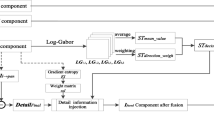Abstract
In this paper, a novel Pan-sharpening algorithm for high resolution Panchromatic (HR PAN) and low resolution multispectral image (LR MS) via regional division and Non-sampled shift-invariance shearlet transform (NSST) is proposed. The purpose of our algorithm is to fuse the LR MS and the HR PAN image for different objects respectively, in order to solve the spectral distortion and spatial resolution problems in the Pan-sharpened image. Firstly, the LR MS and the HR PAN images are divided into structure and non-structure regions respectively, and a regional association map is set according to the division result. A regional similarity measure, degree of regional match (DRM), is proposed to evaluate the correction of the two regions. And a fusion rule is designed based on DRM. Because of the flexibility direction features, NSST can represent the edge information of the image better. Hence the LR MS and the HR PAN images are decomposed by the NSST, and the Pan-sharpened image can be obtained by the designed rule. Experimental results have proved that the proposed algorithm has a better Pan-sharpening result than other methods do.








Similar content being viewed by others
References
Antoine JP, Murenzi R, Vandergheynst P (1999) “Directional wavelets revisited: cauchy wavelets and symmetry detection in patterns”, applied and computational. Harmon Anal 6(3):314–345
Ballester C, Caselles V, Igual L et al (2006) A variational model for P+XS image fusion. Int J Comput Vis 69(1):43–58
Candes E, Demanet L, Donoho D et al (2006) Fast discrete curvelet transforms. Multiscale Sci Model Simul 5(3):861–899
Candès EJ, Donoho DL (1999) “Ridgelets: a key to Higher-dimensional intermittncy?”, philosophical transactions of the royal society of London. Ser A: Math Phys Eng Sci 357(1760):2495–2509
Chen S, Su H, Zhang R et al (2008) The tradeoff analysis for remote sensing image fusion using expanded spectral angle mapper. Sensors 8(1):520–528
Chikr El-Mezouar M, Taleb N, Kpalma K et al (2011) IEEE Trans Geosci Remote Sens 49(5):1590–1602
Do MN, Vetterli M (2005) The contourlet transform: an efficient directional multiresolution image representation. IEEE Trans Image Process 14(12):2091–2106
Easley G, Labate D, Lim WQ (2008) Sparse directional image representations using the discrete shearlet transform. Appl Comput Harmon Anal 25(1):25–46
Guo K, Labate D (2007) Optimally sparse multidimensional representation using shearlets. SIAM J Math Anal 39(1):298–318
Lewis JJ, O’Callaghan RJ, Nikolov SG et al (2007) Pixel-and region-based image fusion with complex wavelets. Information Fusion 8(2):119–130
Li S, Yang B (2008) Multifocus image fusion using region segmentationanf spatial frequency. Image Vis Comput 26(7):971–979
Lim W Q (2009) “Discrete Shearlet Transform: New Multiscale Directional Image Representation”, SAMPTA’09, International Conference on Sampling Theory and Applications, 2009.
Lim WQ (2010) The discrete shearlet transform: a new directional transform and compactly supported shearlet frames. IEEE Trans Image Process 19(5):1166–1180
Miao QG, Shi C, Xu PF et al (2011) A novel algorithm of image fusion using shearlets. Opt Commun 284(6):1540–1547
Nencini F, Garzelli A, Baronti S (2007) Remote sensing image fusion using the curvelet transform. Information Fusion 8(2):143–156
Rahmani S, Strait M, Merkurjev D et al (2010) An adaptive HIS pan-sharpening method. IEEE Trans Geosci Remote Sens 7(4):746–750
Ranchin T, Wald L (2000) Fusion of high spatial and spectral resolution images: the ARSIS concept and its implementation. Photogramm Eng Remote Sens 66(1):49–61
Saeedi J, Faez K (2011) A new pan-sharpening method using multiobjective partical swarm optimization and the shiftable contourlet transform. ISPRS J Photogramm Remote Sens 66(3):365–381
Shah VP, Younan NH, King RL (2008) An efficient pan-sharpening method via a combined adaptive PCA approach and contourlets. IEEE Trans Geosci Remote Sens 46(5):1323–1335
Shahdoosti H R, Ghassemian H (2012) “Spatial PCA as a new method for image fusion,” Artificial Intelligence and Signal Processing (AISP), 2012 16th CSI International Symposium on. IEEE. 090-094
Shi C, Miao QG et al (2013) A novel algorithm of image fusion based on shearlets and PCNN. Neurocomputing 117(10):47–53
Tu TM, Huang PS, Hung CL, Chang CP (2004) A fast intensity-Hue-Shturation fusion technique with spectral adjustment for IJNOS imagery. IEEE Trans Geosci Remote Sens 1(4):309–312
Tu TM, Su SC, Shyu HC et al (2001) A new look at HIS like image fusion methods. Inf Fusion 2(3):177–186
Wang ZJ, Ziou D, Armenakis C et al (2007) Comparative analysis of image fusion methods. IEEE Trans Geosci Remote Sens 43(6):1391–1402
Zhang Y, Hong G (2005) An HIS and wavelet integrated approach to improve pan-sharpening visual quality of natural colour IKNOS and quickbird images. Inf Fusion 70(6):225–234
Acknowledgments
The work was jointly supported by the National Basic Research Program (973 Programs) of China (No. 2013CB329402), the National Natural Science Foundations of China (No. 61173090, 61072109, 61272280, 41271447, 61272195), the Program for New Century Excellent Talents in Universtity (NCET-12-0919), The Fundamental Research Funds for the Central Universities (No. K5051203020, K5051203001, K5051303016, K5051303018 and K50513100006), the Creative Project of Science and Technology State of xi’an (No. CXY1341(6)), the National Research Foundation for the Doctoral Program of Higher Education of China (No. 20110203110006), the Fund for Foreign Scholars in University Research and Teaching Programs (the 111 Project) (No. B07048), the Program for Cheung Kong Scholars and Innovative Research Team University (NO. IRT1170). An EU FP7 IRSES grant (No. 247619) on “Nature Inspired Computation and its Applications (NICaiA)”.
Author information
Authors and Affiliations
Corresponding author
Rights and permissions
About this article
Cite this article
Shi, C., Liu, F. & Miao, Q. Pan-sharpening via regional division and NSST. Multimed Tools Appl 74, 7843–7857 (2015). https://doi.org/10.1007/s11042-014-2027-x
Received:
Revised:
Accepted:
Published:
Issue Date:
DOI: https://doi.org/10.1007/s11042-014-2027-x




